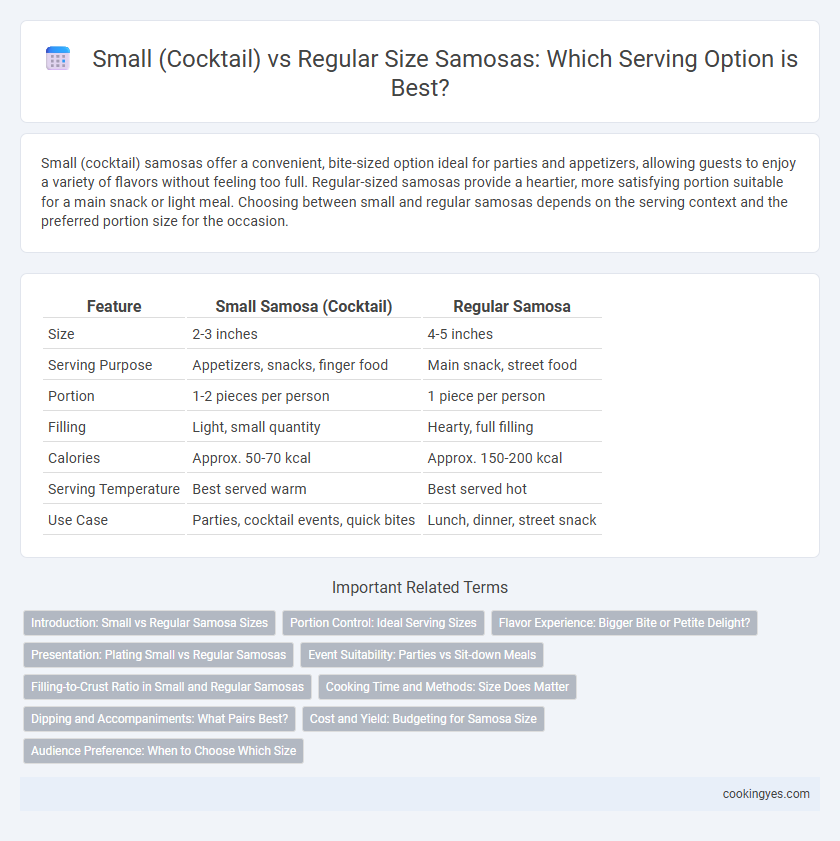Small (cocktail) samosas offer a convenient, bite-sized option ideal for parties and appetizers, allowing guests to enjoy a variety of flavors without feeling too full. Regular-sized samosas provide a heartier, more satisfying portion suitable for a main snack or light meal. Choosing between small and regular samosas depends on the serving context and the preferred portion size for the occasion.
Table of Comparison
| Feature | Small Samosa (Cocktail) | Regular Samosa |
|---|---|---|
| Size | 2-3 inches | 4-5 inches |
| Serving Purpose | Appetizers, snacks, finger food | Main snack, street food |
| Portion | 1-2 pieces per person | 1 piece per person |
| Filling | Light, small quantity | Hearty, full filling |
| Calories | Approx. 50-70 kcal | Approx. 150-200 kcal |
| Serving Temperature | Best served warm | Best served hot |
| Use Case | Parties, cocktail events, quick bites | Lunch, dinner, street snack |
Introduction: Small vs Regular Samosa Sizes
Small samosas, typically measuring around 2 inches, are ideal for cocktail servings, offering a convenient, bite-sized option perfect for appetizers and party platters. Regular samosas, generally 4 to 5 inches, provide a more substantial portion suitable for main courses or snacks, delivering a satisfying combination of crispy pastry and flavorful filling. Selecting between small and regular samosas depends on the occasion, portion preference, and desired balance between presentation and satiety.
Portion Control: Ideal Serving Sizes
Small cocktail samosas offer precise portion control with sizes typically ranging between 15-20 grams, making them perfect for appetizers or bite-sized servings. Regular samosas usually weigh around 80-100 grams, providing a more substantial portion suitable for main snacks or light meals. Choosing small samosas ensures calorie management and variety in a serving, while regular sizes satisfy hunger with fewer pieces.
Flavor Experience: Bigger Bite or Petite Delight?
Small cocktail-sized samosas offer a concentrated burst of flavor in every bite, making them an ideal choice for those seeking a petite delight with a perfectly balanced spice blend and crispy texture. Regular-sized samosas provide a bigger bite experience, allowing for more filling variety and a satisfying contrast between the crunchy exterior and rich, savory interior. Choosing between small and regular sizes affects the overall flavor intensity and mouthfeel, catering to either tasting variety or a more indulgent, hearty snack.
Presentation: Plating Small vs Regular Samosas
Small (cocktail) samosas offer an elegant presentation ideal for appetizers, often arranged in neat clusters on minimalist plates to highlight their bite-sized appeal. Regular-sized samosas are typically plated more generously, allowing for a heartier serving that emphasizes tradition and comfort, often paired with dipping sauces in ramekins. The choice between small and regular samosas influences not only portion control but also visual impact, with smaller samosas enhancing refined, crowd-friendly displays and larger ones providing a robust, rustic aesthetic.
Event Suitability: Parties vs Sit-down Meals
Small (cocktail) samosas are ideal for parties and social gatherings due to their bite-sized portions that allow easy snacking and mingling without utensils. Regular-sized samosas suit sit-down meals where guests expect a more filling appetizer that complements the main course. The choice between small and regular samosas directly impacts event flow and guest satisfaction based on serving style and portion preference.
Filling-to-Crust Ratio in Small and Regular Samosas
Small cocktail samosas feature a higher filling-to-crust ratio, offering a more concentrated burst of savory ingredients in each bite compared to regular-sized samosas. Regular samosas have a thicker crust that balances the filling but can sometimes overshadow the flavors within due to its larger pastry-to-filling proportion. Choosing between small and regular samosas depends on the preference for a richer filling experience or a more balanced crust-to-filling ratio.
Cooking Time and Methods: Size Does Matter
Small cocktail samosas cook faster, typically taking 6 to 8 minutes to achieve a crispy golden texture due to their compact size, while regular samosas require 12 to 15 minutes to ensure the thicker dough and filling are fully cooked. Cooking methods such as deep frying or air frying remain consistent regardless of size, but smaller samosas allow for more even heat distribution and reduced oil absorption. Size directly influences cooking time and texture, making the choice between small and regular samosas important for timing and desired crispiness.
Dipping and Accompaniments: What Pairs Best?
Small cocktail samosas are ideal for dipping into a variety of sauces such as tangy tamarind chutney, spicy green chutney, or cooling yogurt raita, enhancing bite-sized flavor combinations. Regular-sized samosas pair well with heartier accompaniments like thick garlic chutney, sweet onion sauce, or a side of tangy pickled vegetables, creating a balanced and satisfying snack experience. The size influences the dipping method and the intensity of flavors, with small samosas favoring quick, multiple dips and larger samosas suited for richer, more substantial accompaniments.
Cost and Yield: Budgeting for Samosa Size
Small (cocktail) samosas typically cost less per batch but yield fewer servings, making them ideal for budget-conscious events with higher guest counts. Regular-sized samosas have a higher ingredient cost but increase per-piece serving satisfaction, offering better value in terms of portion size and customer fullness. Cost-efficiency depends on balancing ingredient expenses with the desired yield and appetite satisfaction for the specific event.
Audience Preference: When to Choose Which Size
Small (cocktail) samosas are ideal for casual gatherings and appetizers, catering to guests who prefer bite-sized snacks and easy portion control. Regular size samosas suit meal portions and more filling servings, appealing to those seeking a satisfying and hearty bite. Audience preference often hinges on the event type, with small samosas favored for social mingling and regular samosas chosen for main course enjoyment.
Small (cocktail) vs Regular size for Samosa serving Infographic

 cookingyes.com
cookingyes.com